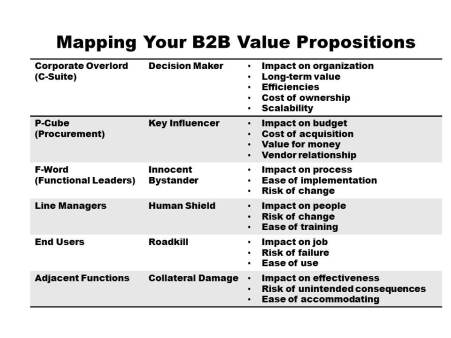One of my favourite business writers, Geoffrey James, once wrote that B2B selling is “not only different from B2C selling, it’s massively more difficult …” . Here’s the whole article.
When we look at the marketing side of B2B, I’m not sure it’s any more difficult than B2C, but I suggest it is considerably more complex.
Beyond the obvious stuff of budgets, products and scale, the mechanics of B2B marketing are not all that different from B2C, but there are a few strategic things that make it a lot more complicated, and one of those is the distance between the decision-maker and the end user.
In the consumer world, the distance is pretty short. That is, the person making the purchase decision and the person actually using the product or service are the same, with the notable exceptions of infant diapers, boarding schools, orthodontists and, possibly, tattoo removal services.
In the business buying world, the distance can be rather greater and will increase with the size of the organization. For example, the decision-maker on a new inventory management system could be the chief financial officer, while the end users will be warehouse managers and fulfillment folks. The challenge, then, is to remember that the value proposition is quite different at either end of this hierarchy and at multiple points in between.
In this scenario, the CFO, with help from the P-Cube, is looking for a system that is scalable, cost-effective, best-in-class and cranks out useful data that supports strategic decision-making. The VP of Logistics is all about pretty reports, but is also interested in real-time information, cost-to-install and efficiency gains. Her directors, card-carrying members of the F-Word contingent, are going to love the pretty reports and real-time data, but will be concerned also with the disruptions the installation will cause and the cost to train their staff to use it.
The warehouse manager will be concerned with productivity losses during the installation and managing change and training times for the staff. The order pickers could care less about the pretty reports, the cost of the thing or the scalability, but they will have a huge interest in how easy it is to use, how easy it is to learn and whether or not it constitutes any kind of negative day-to-day experience or, even their eventual replacement by sentient forklifts.
Elsewhere in the organization, the Customer Abuse department is likely dreading the breaking-in period, during which orders may or may not be going out but it won’t matter because the module that lets the customer abuse department see the order status wasn’t in scope for this phase of the build.
Then there are the bits of your customer’s organization that may not even know about the shiny new inventory system but will be more than a little startled to discover its knock-on effects.
Sales Squirrels, for example, will be unhappy to learn about poor order accuracy and promptness while the new system is brought online, and the human resources folks will have the wet clean-up that results from a less-than-perfect introduction to the end users. They may also be interested to understand what new skills or experience they will need to ask for when they are recruiting end users.
While all of this is, to be sure, your customer’s problem, I would suggest that a good marketer will consider the value proposition for these people too and help their P-Cubers communicate it before the product and brand become the internal code word for “another useless piece of sh*t from the Ivory Tower”.
In the B2C world, by contrast, the value proposition for the diaper buyer and the (forgive me) end user, is pretty tightly aligned. Babies don’t think much about price or packaging, but at the end of it all (sorry), the value proposition around dry, happy babies is shared. Where the value proposition isn’t completely shared, as in orthodontists, they are at least mutually beneficial and frankly, the end user hasn’t really got a lot of choice and can whine all they want, as long as they clean their teeth.
Whether your primary target is the poor schmuck with the thankless task of buying office chairs or the one looking for a new dental plan, it pays to map out the distance between that function and the end user, considering where each sees value (or not) in your product and remembering that sometimes, your stakeholders are actually holding pitchforks.
Here is my helpful diagram:
If you would like a .pdf or .ppt of this, shoot me an email and I’ll send it over.

This article was syndicated from Business 2 Community: Distance Between Decision-Makers and End Users is Key
More Sales & Marketing articles from Business 2 Community:




